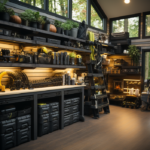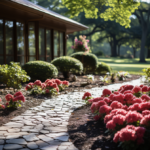Table of Contents
Essential Green Home Improvements for a Sustainable Future
Hey there, eco-warriors and sustainability enthusiasts! Are you ready to make a difference and transform your humble abode into an environmentally friendly oasis? Look no further because we’ve got you covered with our Ultimate Guide to Green Home Improvements!
In this comprehensive guide, we’ll take you on a journey towards a greener and more sustainable home. Together, we’ll explore a range of practical and cost-effective solutions that will not only reduce your carbon footprint but also enhance the comfort and value of your living space.
From energy-efficient upgrades to water-saving techniques, we’ll dive into the world of green home improvements. Discover simple yet effective strategies to minimize energy consumption, like installing LED lights, switching to smart thermostats, and investing in solar panels. Learn about the benefits of composting, rainwater harvesting, and innovative insulation materials that can keep your home cozy while reducing heating and cooling costs.
But that’s not all! We’ll also delve into eco-friendly materials for flooring, furniture, and paint that ensure a healthier indoor environment for you and your loved ones. Plus, we’ll tackle the importance of recycling, reducing waste, and implementing sustainable landscaping practices.
Whether you’re a seasoned eco-enthusiast or just starting your green journey, our Ultimate Guide to Green Home Improvements has something for everyone. So get ready to roll up your sleeves and embark on a sustainable adventure that will truly make a positive impact on our planet. Let’s dive in together and create a greener future, one home at a time!
Making Your Home Energy Efficient
When it comes to green home improvements, one of the most essential aspects is making your home energy efficient. This not only reduces your carbon footprint but also translates into long-term savings on your energy bills. Here are some key areas to focus on:
- Upgrade to LED Lighting: Swap out those old incandescent bulbs for energy-efficient LED lights. They last longer, consume less electricity, and provide the same quality of light.
- Insulate and Seal: Don’t let your hard-earned money sneak out through drafty windows and doors. Properly insulating and sealing your home prevents heat loss in the winter and keeps it cool in the summer, reducing your reliance on heating and cooling systems.
- Invest in Energy-Star Appliances: When it’s time to replace your appliances, make sure to choose Energy-Star certified models. These appliances are designed to operate more efficiently, using less water and electricity without compromising performance.
- Harness the Power of the Sun: Consider installing solar panels to generate clean, renewable energy. Not only will this significantly reduce your reliance on traditional energy sources, but it may also allow you to sell excess energy back to the grid.
- Utilize Smart Thermostats: Take control of your home’s temperature by installing a smart thermostat. These devices learn your habits and adjust temperature settings accordingly, ensuring optimal energy usage.
By implementing these energy-efficient upgrades, you can make your home more environmentally friendly while enjoying long-term savings. Not only will you reduce greenhouse gas emissions and help combat climate change, but you’ll also create a more comfortable and eco-conscious living space for you and your family. Stay tuned for the next part of our Ultimate Guide to Green Home Improvements, where we’ll explore water-saving techniques!
Water Conservation Techniques for a Greener Home
Conserving water is another vital aspect of creating a green home. By implementing these simple yet effective water-saving techniques, you can make a big difference in preserving our planet’s most precious resource:
- Fix Leaks: Check for any leaks in faucets, toilets, and pipes. Even small leaks can waste a significant amount of water over time, so make sure to fix them promptly.
- Install Low-flow Fixtures: Replace your old showerheads and faucets with low-flow options. These fixtures reduce water consumption without compromising on water pressure, helping you save gallons of water every day.
- Consider Dual-flush Toilets: Water-efficient toilets with dual-flush functionality allow you to choose between a full flush or a half flush, depending on the waste. This way, you can minimize water usage while still maintaining sanitation.
- Collect Rainwater: Set up a rainwater harvesting system to collect and store rainwater. This water can be used for gardening, watering plants, or even flushing toilets, reducing the demand on municipal water supplies.
- Reuse Graywater: Graywater refers to gently used water from sinks, showers, and laundry. Consider implementing a graywater system to divert this water for irrigation purposes, reducing the need for freshwater.
- Practice Smart Landscaping: Choose native plants that are well-suited to your climate and require less water. Additionally, use mulch in your garden beds to retain moisture and reduce the frequency of watering.
By adopting these water conservation techniques, you can significantly reduce your water consumption and contribute to a greener planet. Each drop saved counts towards safeguarding our water resources for future generations. Stay tuned for the next part of our Ultimate Guide to Green Home Improvements, where we’ll explore eco-friendly materials for a healthier living environment!
Eco-Friendly Materials for Flooring, Furniture, and Paint
When it comes to creating a green home, the materials you choose for your flooring, furniture, and paint make a significant impact on both the environment and your indoor air quality. Here are some eco-friendly options to consider:
- Sustainable Flooring: Opt for eco-friendly flooring materials such as bamboo, cork, or reclaimed wood. These materials are renewable, biodegradable, and have a smaller carbon footprint compared to traditional hardwood or carpeting.
- Non-Toxic Paint: Conventional paints often contain volatile organic compounds (VOCs), which release harmful gases into the air. Choose low or zero VOC paints to reduce indoor air pollution and create a healthier living space.
- Recycled or Upcycled Furniture: Instead of buying new furniture, search for recycled or upcycled options. There are many creative individuals and companies that transform old furniture into beautiful, functional pieces while reducing waste.
- Natural Fiber Upholstery: When it comes to upholstery, opt for natural fibers like organic cotton, linen, or hemp. These materials are renewable, biodegradable, and free from harmful chemicals.
- Reclaimed Materials: Consider using reclaimed materials for your home improvement projects. Salvaged wood, bricks, and tiles not only add character and uniqueness but also reduce the demand for new materials.
- Indoor Plants: Incorporate indoor plants into your home decor. They not only brighten up your space but also improve air quality by absorbing airborne toxins and releasing oxygen.
By choosing eco-friendly materials for your flooring, furniture, and paint, you can create a healthier living space while minimizing your environmental impact. Embrace sustainability and add a touch of nature to your home. Stay tuned for the next part of our Ultimate Guide to Green Home Improvements, where we’ll delve into the importance of recycling, reducing waste, and sustainable landscaping practices!
Recycling and Waste Reduction in Your Green Home
Reducing waste and implementing recycling practices are crucial steps in creating a green home. Here are some essential tips for minimizing waste and maximizing recycling:
- Reduce Single-Use Items: Avoid single-use items like plastic water bottles, straws, and disposable cutlery. Opt for reusable alternatives such as stainless steel water bottles, bamboo utensils, and cloth shopping bags.
- Separate and Recycle: Set up a recycling system in your home. Make sure to separate recyclables like paper, plastic, glass, and metal from regular waste. Check your local recycling guidelines for specific instructions on what can be recycled in your area.
- Compost Food Scraps: Start composting your food scraps to divert them from the landfill. Composting not only reduces waste but also creates nutrient-rich soil for your garden.
- Donate and Repurpose: Instead of throwing away items you no longer need, donate them to local charities or thrift stores. Additionally, get creative and repurpose old items for new purposes. Turn glass jars into storage containers or transform old furniture into unique pieces.
- Buy Second-Hand: Consider purchasing second-hand items whenever possible. Thrift stores, online marketplaces, and yard sales are treasure troves of pre-loved, high-quality items at affordable prices.
- Minimal Packaging: Opt for products with minimal or eco-friendly packaging. Choose items sold in bulk or those packaged in recyclable materials to reduce waste.
By incorporating these waste reduction and recycling practices into your daily routine, you’ll contribute to a greener planet by minimizing waste sent to landfills. Stay tuned for the next part of our Ultimate Guide to Green Home Improvements, where we’ll explore sustainable landscaping practices to complete your eco-friendly oasis!
Sustainable Landscaping Practices for a Greener Outdoor Space
Creating a green home extends beyond the walls. Your outdoor space is an excellent opportunity to incorporate sustainable landscaping practices that are beneficial for the environment. Consider the following tips for a greener outdoor space:
- Native Plants: Opt for native plants in your landscaping. Native plants are adapted to the local climate, requiring less water, pesticides, and fertilizers. They also support local wildlife and promote biodiversity.
- Xeriscaping: Xeriscaping is a water-efficient landscaping technique that focuses on using drought-tolerant plants and minimizing water usage. It reduces the need for irrigation and helps preserve water resources.
- Rain Gardens: Create a rain garden by designing a shallow depression in your yard to collect and absorb rainwater. This helps prevent runoff and reduces the strain on stormwater systems.
- Drip Irrigation: Install a drip irrigation system to ensure that water goes directly to plant roots rather than being wasted through evaporation or runoff. This targeted approach conserves water and promotes healthier plant growth.
- Mulching: Apply organic mulch around plants and garden beds. Mulch helps retain moisture, suppresses weed growth, and adds organic matter to the soil as it decomposes.
- Companion Planting: Implement companion planting techniques to naturally deter pests and reduce the need for chemical pesticides. Planting certain combinations of flowers, herbs, and vegetables can create a harmonious ecosystem in your garden.
By incorporating these sustainable landscaping practices, you can create an outdoor space that is not only beautiful but also ecologically friendly. Embrace the natural beauty of your surroundings while minimizing your environmental impact. Stay tuned for the next part of our Ultimate Guide to Green Home Improvements, where we’ll wrap it all up with some final thoughts on creating a sustainable and green home!
Conclusion
Congratulations, eco-warriors, you’ve reached the end of our Ultimate Guide to Green Home Improvements! We hope this guide has equipped you with valuable knowledge and inspiration to transform your home into an eco-friendly haven. By implementing energy-efficient upgrades, conserving water, choosing eco-friendly materials, reducing waste, and practicing sustainable landscaping, you’re taking significant steps towards creating a greener future.
Remember, every small change you make in your home can have a ripple effect on the planet. From reducing your carbon footprint and conserving resources to creating a healthier living environment for you and your loved ones, your efforts matter.
So, let’s continue to spread the word and encourage others to make their homes more sustainable too. Share your experiences, tips, and successes with friends, family, and your wider community. Together, we can make a collective impact and accelerate the transition to a more sustainable world.
Thank you for joining us on this journey. Let’s continue to make conscious choices and build a greener future, one home at a time. Here’s to a brighter, cleaner, and more sustainable future for all!









